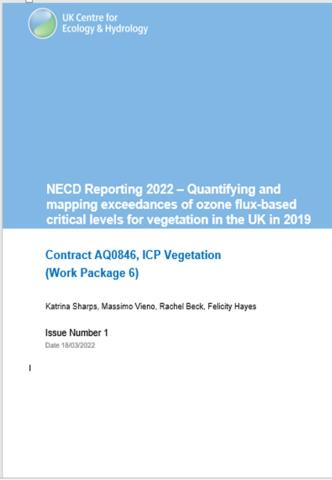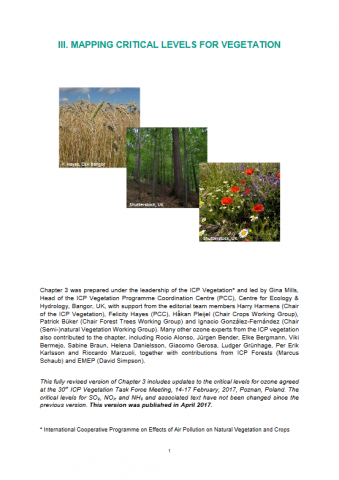Bibliography
.
2007. Predicting community sensitivity to ozone, using Ellenberg Indicator values. Environmental Pollution. 146:744-753.
.
2014. Ozone - the persistent menace: interactions with the N cycle and climate change. Current Opinion in Environmental Sustainability. 9-10:9-19.
.
2007. Ozone risk assessment for agricultural crops in Europe: Further development of stomatal flux and flux-response relationships for European wheat and potato. Atmospheric Environment. 41:3022-3040.
.
2018. Ozone pollution will compromise efforts to increase global wheat production.. Global Change Biology. 24:3560-3574.
.
2016. Ozone impacts on vegetation in a nitrogen enriched and changing climate. Environmental Pollution. 208:898-908.
.
2015. Ozone and plants. Environmental Pollution. 202:215-216.
.
2020. Organochlorines burden in moss H. cupressiforme and topsoil across Serbia. Environmental Geochemistry and Health.
.
2011. Nitrogen concentrations in mosses indicate the spatial distribution of atmospheric nitrogen deposition in Europe. Environmental Pollution. 159:2852-2860.
.
2011. New stomatal flux-based critical levels for ozone effects on vegetation. Atmospheric Environment. 45:5064-5068.
.
2010. Mosses as biomonitors of atmospheric heavy metal deposition: Spatial patterns and temporal trends in Europe. Environmental Pollution. 158:3144-3156.
.
2008. Metal accumulation in mosses across national boundaries: Uncovering and ranking causes of spatial variation. Environmental Pollution. 151:377-388.
.
2007. Meta-analysis of the relative sensitivity of semi-natural vegetation species to ozone. Environmental Pollution. 146:754-762.
.
2014. Mapping correlations between nitrogen concentrations in atmospheric deposition and mosses for natural landscapes in Europe. Ecological Indicators. 36:563-571.
.
2011. Limited potential of crop management for mitigating surface ozone impacts on global food supply. Atmospheric Environment. 45:2569-2576.
.
2007. Implications of climate change for the stomatal flux of ozone: A case study for winter wheat. Environmental Pollution. 146:763-770.
.
2006. Impacts of summer ozone exposure on the growth and overwintering of UK upland vegetation. Atmospheric Environment. 40:4088-4097.
.
2007. Identifying ozone-sensitive communities of (semi-)natural vegetation suitable for mapping exceedance of critical levels. Environmental Pollution. 146:736-743.
.
2015. Heavy metal and nitrogen concentrations in mosses are declining across Europe whilst some "hotspots" remain in 2010. Environmental Pollution. 200:93-104.
.
2014. Have ozone effects on carbon sequestration been overestimated? A new biomass response function for wheat Biogeosciences. 11:4521-4528.
.
2009. First thorough identification of factors associated with Cd, Hg and Pb concentrations in mosses sampled in the European Surveys 1990, 1995, 2000 and 2005. Journal of Atmospheric Chemistry. 63:109-124.
.
2010. First Europe-wide correlation analysis identifying factors best explaining the total nitrogen concentration in mosses. Atmospheric Environment. 44:3485-3491.
.
2011. Evidence of widespread effects of ozone on crops and (semi-)natural vegetation in Europe (1990-2006) in relation to AOT40-and flux-based risk maps. Global Change Biology. 17:592-613.
 ]
] 
